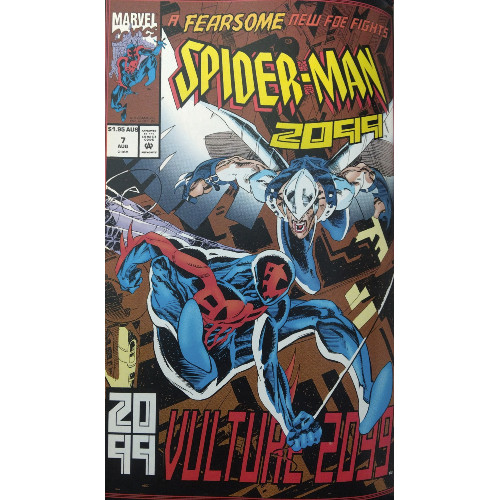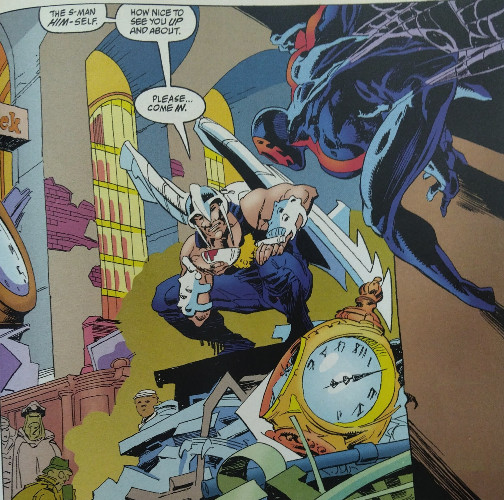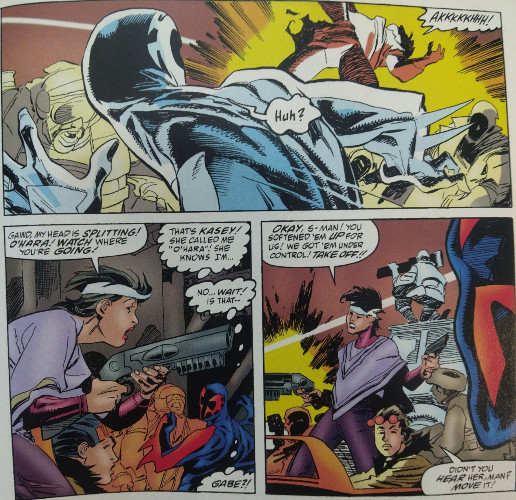Spider-view: "Downtown" (Spider-Man 2099, Part 3)
Peter David introduces a fascinating villain and conducts more great character development in this three-parter
—by Nathan on May 13, 2025—

Over the last few posts, we've explored the Peter Parker side of the Spider-verse, particularly noting his misadventures with the journalist-turned-villain-turned-vigilante Venom. When he isn't trying to rip off Spidey's head, Venom's...trying to rip off other people's heads. It's a lot, but hey, it was the 90s. And I wish I could tell you our little detour into the future means folks have matured somewhat in the last century or so, but alas, it seems "Nueva York" has taken those violent, edgy tropes and integrated them deep within her maglev roads...and far below, as we shall see.
After defeating the samurai warrior called the Specialist in his previous adventure, Spider-Man 2099 was unceremoniously dumped off the edge of New York, falling into the depths of "Downtown," or the "old" New York. You see, in 2099, instead of expanding outward, the Big Apple expanded upward; casting aside the old buildings that represent a bygone era, this Nueva York replaced the old world with towering behemoths of metal and industry, neon lights, and cars that could fly. Down in the "old world," gangs run amok, doctors perform surgeries in cramped quarters, and (gasp!) cars drive on wheels! Such barbarism!
It's this realm Spidey 2099 finds himself in at the start of his latest outing, lost in an unknown world like a spider out of its web.
"Downtown"
Writer: Peter David
Penciler: Rick Leonardi
Inker: Al Williamson
Colorists: Noelle Giddings and Steve Buccellato
Letterer: Rick Parker
Issues: Spider-Man 2099 (vol. 1) #6-8
Publication Dates: April 1993-June 1993

This story stuck in my mind the very first time I read it, on an airplane headed to Florida back in 2009. It may be an odd setting for such a specific memory to form, but reading this particular tale must have sunk into my cranium deep for me to remember details such as where I was upon reading these issues. And I think I can easily recall reading this story for one particular reason: the Vulture.
Finally, after facing two wholly original opponents, Spidey 2099 goes up against a foe who has some connection to original Spider-Man lore. Though the future Vulture has little in common to that old, green-winged buzzard Adrian Toomes, I remember simultaneously loving and being terrified the first time I saw the villain grace the page. I loved him because, again, here was a beautiful nod to previously established continuity, a great example of how a creator could take a used concept and make it new. And he terrified me because his first appearance is marked by him murdering a couple thugs and police officers and, later on, devouring the corpses of those same individuals.

The Vulture of 2099 is a dark character, and upon rereading this story for the umpteemth time, I started seeing layers to him I had missed, my senses perhaps originally clouded by offal and blood. Thirteen-year old me saw a degenerate cannibal, a monster who (both interestingly and unnervingly) tangibly fulfilled his namesake in a way Toomes never had. While good old (except for when he was young) Adrian Toomes "preys" upon whoever he can by stealing their trinkets and treasures, this unnamed Vulture feeds upon his enemies. Taken in a nastier, literal direction, this Vulture stands head-and-shoulders above the rest of the adversaries Spidey has yet faced.
Spidey's role, though significant, pales in comparison to the brutality of his winged foe; anytime I've wanted to peruse this story, it's always been for the Vulture, and my recent readthrough opened my eyes to those additional layers I mentioned earlier: amusingly, this Vulture is not naturally a predator, but one who became a hunter after languishing as prey. David inserts social commentary into the story by turning the Vulture into a representative of the lower classes who feel oppressed by the oligarchical corporations that run New York, a theme I didn't quite understand or pick up on when I was younger. I appreciate David's approach to injecting his story with commentary–he doesn't do it in a beat-you-over-the-head manner. His point doesn't come across as a vehement attack on real-world institutions, nor does it strive to offer any potential tangible solutions to real-world problems. Though he makes the Vulture's stance on the society of 2099 obvious, David allows us the chance to interpret this character and his motivations and apply them to our modern era. Yet, at the same time, the Vulture is very clearly a monster: though he may spout exposition on certain beliefs David himself (or, more likely, some readers) may cling to, his methods are suspect at best and downright deplorable at worst.

David's social commentary dovetails (I guess that's a pun?) nicely with Miguel's story, because now we have a character who's even further torn. Miguel has progressed, in a very short amount of time, from a busy little worker bee to a hero who could represent the opposite side of the coin. It is, admittedly, a frustrating position to be in, and one Miguel doesn’t embrace wholeheartedly. He’s legitimately torn–on the one hand, after gaining his powers, he can no longer turn a blind eye to the injustices performed by his current employer, but on the other, he refuses to sink to the depths a cannibal like the Vulture dwells in. This creates an entertaining, intertwined narrative that ultimately points to the fact that even things that look black-and-white can occasionally have shimmers of gray–just because you want to stand up for the teeming, oppressed masses, does that make it right to literally devour your enemies? I mean, I know "eat the rich" is a popular thing to say, but we don't mean that literally, right, guys?
...right, guys?
Moving away from the socio-political aspects of the tale, I'd like to focus on a few other points regarding supporting characters. Miguel's brother Gabe gets a small arc of his own as he journeys Downtown to look for his girlfriend, Kasey. While not overly endearing to me, Gabe is still an interesting character, and you call tell David is working to give him more characterization. History between him and Miguel's fiance Dana is hinted at, he's given a few quips to flesh out his dialogue ("How would a shot at your head be a threat to your brain?" he asks one character–roasted), and David even ends one of the issues with a cliffhanger caused by Gabe. While on his own misadventure, Gabe becomes involved in some of Kasey's more illegal activities (aka, leading a gang of heavily armed Downtown activists), and though I can't safely say this creates ongoing character development for Gabe (i.e. co-leading a gang of heavily armed Downtown activists), it's a unique direction for him to take and at least promises that idea that David has some idea where to take the character.

Although I can't recall from my previous readthrough of the series, I would like to point out a subplot David is introducing between Miguel and Gabe. Gabe, earlier in the series, seemed to recognize the outfit Miguel wore as his Spidey outfit (an old Day of the Dead costume made of unstable molecule fabric, or UMF) and confronted Lyla at a moment where Miguel seemingly disappeared. David seems to be indicating that Gabe at least suspects that Miguel is Spidey, and while I don't remember the direction this subplot takes, I'll be glad of whatever potential conflict arises from it should it be touched on down the line.
Like other pieces in this series, it's a twist on a classic Peter Parker trope: back in the good old days, Peter could whip up any number of excuses for tardiness, unexplained absences, and bizarre bruises and cuts caused by his alter ego's escapades. And everyone seemed to believe his plethora of fictions. While entertaining, it would get to the point where his lies could strain credibility–yes, in a world populated by people with superhuman abilities who regularly demolish cities while beating the tar out of one another, this is what I'm harping on for the moment–and has reached, I would argue, cliche status. Time after time, characters would fall for Peter's often outlandish explanations, and while several individuals chalked it up to what they perceived as Peter's natural aloofness, this running gag still feels a tad grating as it's continually used. So for David to have a character in this series who seems capable of seeing through the wool Miguel attempts to pull over their eyes in refreshing.

Even now, this story holds up and, in certain cases, has even improved in my eyes since I first read it over a decade ago. This was the story which cemented Miguel O'Hara as a worthy addition to the "Spider-Family" and a worthy successor to the webs. A villain who was originally in my mind just a really interesting take on a classic foe has, over the years, developed a deeper personality; a side character who came across as a goofy brother is, for now, being imbued with more of a personality. It's been a while since I've delved into the rest of this universe, and I'm excited to see what directions David takes the story as I dive deeper...though not literally, because Miguel will be back "topside" the next time we see him.